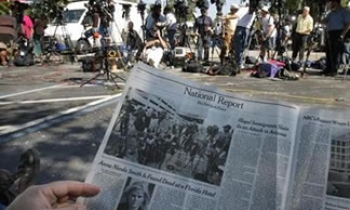MUMBAI: The print and the broadcast sector - A reality check was what The Hindu editor-in-chief N Ram and Star India CEO Peter Mukerjea voiced at session four of the 'Diamond Jubilee seminar' on the media and entertainment sector.
"The world's best newspaper Financial Times is losing circulation & is trying to make up its losses through its internet edition," were the strong words stated by Ram. The newspaper segment is facing a time of concern as the reading habit of people worldwide are deteriorating, more so in the mature markets.
"It is only political excitement that drives up circulation, and any talk of escaping the political context is futile," Ram stressed.
Newspapers revel in situations of political conflict and are sanitized when the political scenario is stable. "Dainik Jagram has managed a total readership of 21 million according to NRS 2005 figures, which is very encouraging for the print business," said Ram.
Ram also vehemently expressed his disappointment on advertising putting pressure on the editorial and the format per se. "A journalist like me has a love-hate relationship with the advertisers. But one is also bound by it."
Projecting into the future, he said that the world was heading towards the compact way (tabaloidisation). "On 17 October, The Wall Street Journal is going compact."
Not only has compact journalism become the way ahead for the newspaper business, but increasingly visuals are also becoming vital to stay ahead of the game, despite the good content one may bring to the table.
"Time spent on reading newspapers is extremely thin and is a precarious scenario, and if we don't track eye-balls we have a major problem at hand," averred Ram.
Newspapers will decline unless it learns to make a deep connect with the reader and understands what the reader is looking for. Compared to most countries, India is still in a very buoyant state if one looks at the NRS 2005 figures. Non-metros and small towns is where the growth for the print business is coming from when readership almost touching 50 per cent.
Although, the growth of print is nor comparable to the C&S growth, it is still shows better growth that radio. Coming to the Internet, India total claims a total of 11 million users and compares very poorly with China which enjoys 90 million users, so, as a sector it is still fairly underdeveloped. Said Ram, "So, although we don't have to fear in the short term or the medium term, the long tem is something we all need to work towards."
Ram celebrated the fact that India today still believes in relatively free and independent journalism , although he pointed out that the training and codes of professional conduct imparted to journalist need to be spruced up.
Ram ended his session urging advertisers to value good content and not dumb down for their short term goals. "Please recognize the values of journalism and fit it into your schemes of things," were the editor-in chief's closing appeal to the marketing and advertising fraternity.
Mukherjea on the other hand talked about the digital drive and gave the audience a sneak peak into the future, the gist being 'Innovate to survive'. He raised an important question - "Will advertising change or will the advertising people change?" The digital era will set in motion a whole new revolution in the way television content is produced, distributed and consumed.
"Viewers can have one minute episode of Kyunki on their mobile phones. Fox has already launched one minute mobisodes of TV shows. In India, this kind of compressed content will come sooner rather than later," said Mukerjea.
While broadcasters will have to improve content and expand reach for the digital era, media consumption habits will change as the next set of viewers will be able to access media on demand. The delivery mechanism of content is also changing and British Telecommunication (BT) recently announced its intentions of sending video over its phone lines. "We are moving into interactive TV and a digital wireless world," he added.
IPTV is already big in Japan and is gaining ground rapidly in other countries as well. The personal video recorded (PVR) which enables the viewer to return to the show from where he left ensuring the experience of viewing it in real time is the also a technology is fast catching on. " Ad delivery mechanisms change, advertisers also need to innovate on how to grab the attention of the restless viewer who would now be in control of what, when and how he wants to view television." Mukherjea added that 'Prime time is my time' is a phenomenon that needs to be acknowledged by the media. All the major electronic players of the world are currently working on developing 'anywhere TV'.
While the advancing technologies may pose as a big threat for advertisers, it is also lends a great opportunity in terms targeting a focused set of consumers. Mukerjea ended saying" Its time to open the floodgates of innovation by becoming more nimble and listening intently to the viewer."









